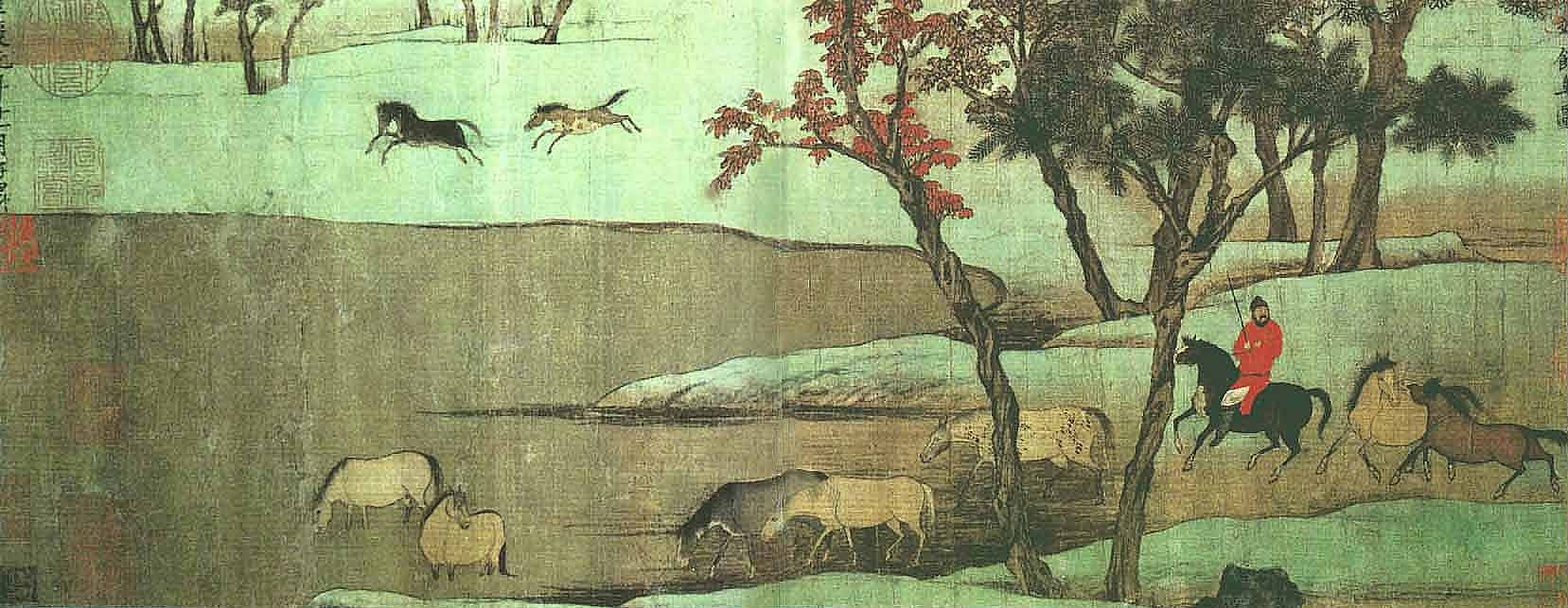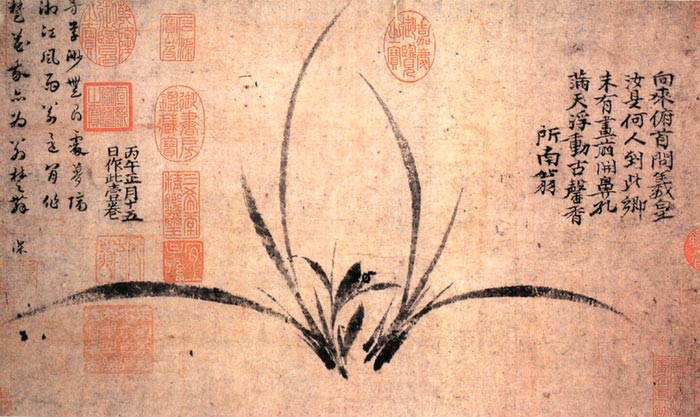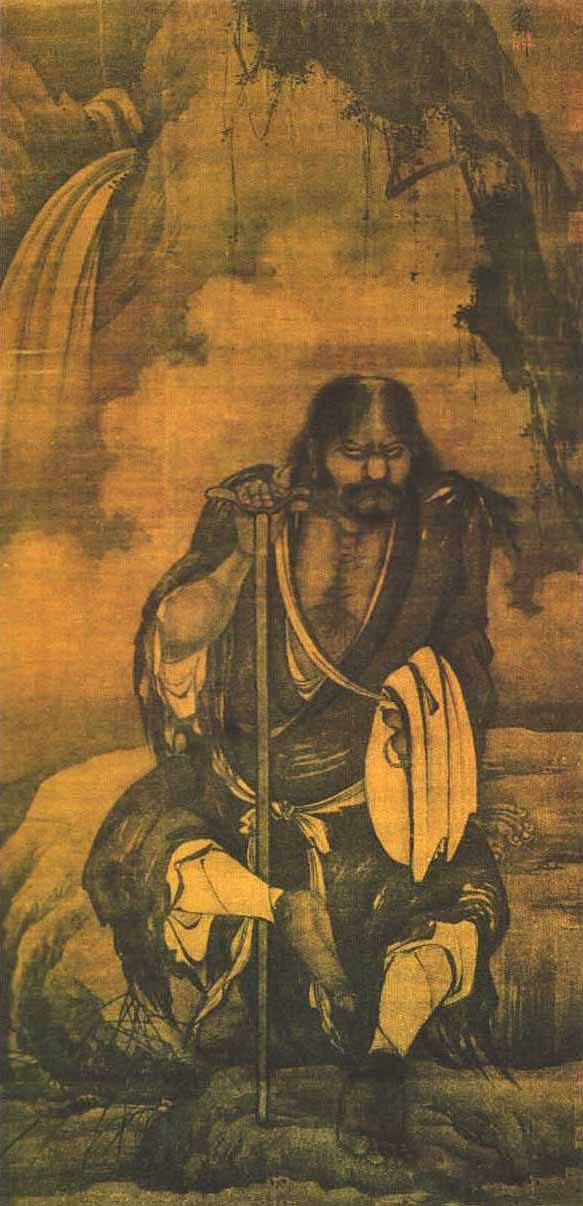|
| |

|

VI.
The Yuan Dynasty
In 1276, the Mongolian forced the Southern Song into surrender and officially became the first grasslands nationality who ruled the whole mainland China. The rulers of the Yuan Dynasty divided the population into four classes with the Mongolian occupying the highest rank, and then the second rank Semu (people with colored eyes, including Central Asian allies of the Mongols, mostly Uighurs and other Turks), the third rank Han Chinese (the northern Chinese formerly ruled by the Jin Dynasty), and the lowest rank the Southerners (the southern Chinese formerly ruled by the Southern Song Dynasty). The Han Chinese lived of low social status. The rulers did not set up the imperial examination system at the beginning of Yuan Dynasty; therefore, except for very few Han Chinese reaching the highest-post in the government, most Han Chinese could only serve as petty officials at that time. For the racial policies that severely discriminated against Han Chinese and restricted them from ascending the civil service ladder, most literati who would not to cooperate with Mongolian had to earn a living by teaching, practicing medicine, divination, and selling paintings. Drama writing was another source of revenue for them, which greatly promoted the prosperity of drama literature in Yuan Dynasty. On the other hand, as a vehicle for expressing literati's thought and feeling, literati painting became more popular as well. Since there was no imperial painting academy in the Yuan Dynasty, in addition to a few professional painters who worked for the court and some high-ranking literati officials, most painters were amateur literati painters outside the court. The literati painting was mainstream is this period. |
|
At the beginning of Yuan Dynasty, there was a group of adherent painters who lived in southern China and who often expressed their nostalgia of the old Song Dynasty in their paintings. Gong Kai, Zheng Sixiao and Qian Xuan were the representatives among them. Gong Kai used to serve the Song government as a minor official before the Yuan proclaimed a dynasty, and after that, his only sources of income were the sale of paintings and calligraphy. His main themes were ghosts and bony horse. |
 |
In his famous painting "Zhong Kui Traveling with his Sister"(a collection of the Freer Gallery of Art in USA), Zhong Kui (a vanquisher of ghosts and evil beings) and his sister are being carried by several demons who are pictured as gangly, grotesque creatures wearing only loin clothes or barely more than skin and bones. In another famous painting "Emaciated Horse", the horse he depicted is almost a mere skeleton with a slouchy head, seemingly containing deep consciousness of suffering and sorrow with the last pieces of his shattered dignity. These images of non-human and eccentric horse can be said a portrayer of Gong Kai's resentment after the ending of Song. Zheng Sixiao was an imperial student at the end of Song Dynasty, as well as a Song loyalist. After Song Dynasty ended, he swore not to associate with the northerners, and no matter when he sit or lied down, he always faced the south. He called himself "Suo Nan" (toward the south). In his masterpiece "Ink Orchid", there is no earth under the orchid leaves. When people asked him why not paint the earth, he answered, "don't you know the earth has been occupied?" Qian Xuan also sold paintings for living in Yuan Dynasty. He once wrote poem to express his opinion as "regardless of the rise and fall of dynasties, I drink with my paintings". The "Dwelling in the Fuyu Mountains" is his representative landscape painting, and he was also good at flower-and-bird painting. On most of his paintings there are poem inscription and postscript combining the poem and painting, which adopted by later painters gradually.
The former Song capital of Hangzhou was a center with many scholars and literati gathered, including the famous painter Zhao Mengfu. Zhao Mengfu was a descendant of the Song Dynasty's imperial family. After the conquest of Hangzhou by Mongols, Zhao had stayed at home for ten years and only associated with some friends who also liked poetry, calligraphy and painting. In 1286 when Kublai Khan sent officials to the south to recruit for scholars, Zhao was recommended to pay an audience with Kublai Khan at the Yuan capital of Dadu. From then on he chose a path different from most Southern Song adherent painters. In 1316, Zhao Mengfu was offered the position of President of the Hanlin Academy, the most prestigious body of scholars in China, and almost the highest position a Han Chinese could reach in Yuan Dynasty. Taking advantage of his position, Zhao collected a large number of masterpieces of the Tang Dynasty and Northern Song Dynasty, and from which he gained inspiration to get away from the Southern Song painting style. He had made contributions to landscape painting, figure painting, as well as saddle-and-horse painting. Derived from the ancient style of Tang Dynasty and the magnificent atmosphere of Dong Yuan and Ju Ran's painting, he created outstanding landscape painting like "Autumn Colours on the Qiao and Hua Mountains", a realistic work created to comfort his friend's homesick. As a milestone in the history of Chinese landscape painting, it mixed sceneries of the northern mountains and the southern waters, with both characteristics of ink landscape and blue-and-green landscape, which had greatly influenced the Four Masters of Yuan Dynasty and later painters. His important landscape works include "You Yu (Xie Kun) Sitting by the Hills", "Dongting Dongshan Mountain", "The Rivers and Overlapping Peaks", "Scenery at Wuxing", and "Water Village". For the figure painting and saddle-and-horse painting, as reflected in his "Watering Horses on Autumn Suburb" and "Bathing Horses", Zhao combined the majesty in the Tang Dynasty and the elegant in the Song Dynasty, accurately and vividly displaying a great variety of brushwork. "A Man and His Horse in the Wind" that depicted a man and a horse in a blowing gale, has the feature of northern nomadic horse painting. "Lohan in a Red Robe" shows the influence of Lu Lengqie (Tang Dynasty painter who was good at Lohan painting). In his "A Sheep and A Goat", the sheep lifts its head up high, while the goat lowers its head down, which was said to symbolize the relationship between Mongols and Chinese in Zhao's mind. If we removed the inscription between these two creatures, the interaction will be more obvious. His painting of dry wood, bamboo and stone refers back to an early mode of the literati painting in Northern Song Dynasty by emphasizing on artistic conception and focusing on individual elements of the painter. It was Zhao Mengfu that first raised the famous theory of "integrating calligraphic skills into painting", "calligraphy and painting are basically the same", asserting the equivalence of painting and calligraphy through calligraphic brushwork and the placement of inscriptions on the picture surface. We can see how his opinion is reflected in his "Elegant Rocks and Sparse Trees". It is worth mentioning that although Zhao Mengfu was belittled and despised in his whole life by Han Chinese for taking the position offered by Yuan rulers, he did not help Mongols to bully the Han Chinese; on the contrary, he introduced the Confucian moral standards to the Mongolian government with all his force; he made recommendations for reforming the monetary system; he assisted to depose the Semu prime minister Sang Ge, who was notorious for his corruption; he proposed that literati and scholars should have the right to be immune from corporal punishment. This tension between Zhao's political career and his personal intention would find its clearest expression in his artistic pursuits. Though Zhao Mengfu had parted company with Qian Xuan politically, in the concept of art, the two were like-minded. They both sought to convey a "spirit of antiquity" (Gu Yi) and a "atmosphere of scholar" (Shi Qi), which was greatly appreciated by the literati painters in Yuan Dynasty. Zhao Mengfu was not the only painter in his family. His wife Guan Daosheng is noted as the first female painter in China, his son Zhao Yong was good at painting, and his grandson Wang Meng is one of the "Four Masters of Yuan Dynasty". |
 |
There was another literati painter who was from Jiangnan in the early Yuan Dynasty. Ren Renfa was a great painter as well as a great water conservancy expert. He was in charge of the construction of projects like Wusong River, Yellow River, Lian Lake, Daying Port, Wunijing and seawall engineering. He is best known for his paintings of figure and saddle-and-horse, which was one example in a tradition begun by Han Gan in the Tang dynasty. His representative works include "Zhang Guolao Meeting with Emperor Minghuang" and "Two Horses". The "Two Horses" depicted one fat horse, which was said to be a metaphor of corrupt official, and one skinny horse, a metaphor of honest official. This kind of symbolic implication was not uncommon for paintings in Yuan Dynasty.
|
Among the northern painters in the early Yuan Dynasty, Gao Kegong had the highest reputation. He was Uighurs, a Semu, and a high rank official. His early career was characterized by wet brushwork of Mi Fu's cloudy mountain, while later in his career he switched to the dry brush of Dong Yuan and Ju Ran. The "Cloud Resting on the Mountain" is his representative work. Another northern painter Li Kan is famous for his bamboo. Li followed the style of Su Shi and Wen Tong, and record his observation of different bamboos and painting skills in his album "Guidance on Bamboo" (Zhu Pu). He worked his way up from a minor official to be minister of the Ministry of Civil Personnel and Secretary of the Jixian Grand Council in Yuan; and along with Zhao Mengfu, he was one of the two highest-ranking Han Chinese painters in Yuan government. However, since the north had been ruled by foreign rulers for a long time, people were not so hard on the northern Chinese who served in the Yuan's government as on the southerner.
In the late Yuan Dynasty, Emperor Renzong reintroduced the traditional imperial examinations for prospective officials; Emperor Yingzong and Emperor Wenzong carried out positive cultural policies; however, the imperial examination system was still biased in favor of Mongols and Semus, while the low social position of Han Chinese was unchanged. In this period most of literati painters were mainly in the Jiangsu and Zhejiang region, such as the so-called "Four Masters of the Yuan Dynasty", Huang Gongwang, Wu Zhen, Ni Zan and Wang Meng. The four painters who lived and worked at approximately the same time were all skilled in landscape painting ,and were all influenced by Zhao Mengfu. Although they had different backgrounds and experiences, their unappreciated situation was similar.
Huang Gongwang was the oldest of the Four. He used to be a clerk of the Zhejiang investigation official, but was put in prison for involving in his boss's corruption case; though he was found innocent and released later, he had been disillusioned and gave up his official career, and made a living by divination and teaching as a Taoist. He pioneered the use of light ocher to color his landscape paintings. Though having once followed the model and techniques of great painters such as Dong Yuan and Ju Ran, Huang himself was an innovative landscape painter who created his own style. The painting "Life in Mount Funchun" was a product of more than three years of weaving together the autumn sceneries along the Fuchun River. When Huang Gongwang finished this work, he was already 82. It is a roll of 6 meters long, with scenes changing from mountains and hills to the river and marsh and then to mountains and peaks again. The brushstroke generates a calligraphic effect, and achieves a artistic state of blandness or the Neutral.
There were two stories about Wu Zhen: he lived by divination and was poor all his life; or, his family ran a shipping business and he never worried about money. About his personality there was no dispute: he was aloof from politics and material pursuits as long as he lived. Wu was good at using wet ink to produce rich textures of mountains, rocks and trees, creating a lush and misty effect. The "Fisherman" is his representative work.
Ni Zan was born into a wealthy family in Wuxi. For heavy taxes imposed on the rich landowners of the region, he distributed all of his possessions to his friends in his fifties, and started to live a vagabond life from then on. He stayed in Zen temple or at a friend's home, and in his old age, he moved into a houseboat traveling throughout the relatively peaceful southeast. Generally in Ni Zan's painting there is pavilion but no people, water but no boat, without any further suggestion of human presence, and elemental landforms with a somber quiet throughout. His composition seems fragile but contains internal balance, while his brushstroke seems simple but is difficult to imitate. The frustrated literati loved his works, and regarded him as a paragon of literati painters. His representative works include "Autumn Clearing over a Fishing Lodge", "Six Gentlemen", and "Bamboo, and Elegant Stone", etc.
Another painter Wang Meng is rather special. He came from an elite family with both of his grandfather and uncle were great painters, which was probably a reason why he was not as determinative on political career as the other three masters. During the turmoil from the end of Yuan Dynasty to the beginning of Ming Dynasty, he constantly worked for the government as a minor official in both dynasties. About his landscape painting, the mountains and stones are usually dense and distorted; however, they appear not crowded by following an inherent order; such feature can be found in his "Dwelling in the Qingbian Mountains", "Moving to Gezhi Mountain", and "Dwelling in Seclusion in the Summer Mountains". In the early Ming Dynasty, in order to consolidate his political power, Zhu Yuanzhang had the Senior Grand Councilor Hu Weiyong arrested and executed on charges of treason, and by using this as an opportunity to purge his government, executed more than thirty thousand people. Wang Meng was put in prison for this reason and shortly after that, he died in prison.
Being different from the predecessors who built achievement on their last generation's shoulder consistently, the Four Masters of the Yuan Dynasty developed the movement pioneered by Zhao Mengfu, which was studying directly from the ancient they chose from the entire art history; imitation of nature was replaced by expressing the artist's temperament and spirit; the gap between the literati painting and non-literati painting began to form.
|
| Due to the complicated situation of races, classes, and social contradictions in Yuan Dynasty, painters were mostly willing to choose landscapes, dry woods, bamboos and stones, flower-and-bird to express their feelings; although there were a few superb figure painters, but they didn't change the relatively shrinking situation of this painting genre, nor became a significantly trend. As a court painter at the beginning of Yuan Dynasty, Li Guandao depicted in his "Kublai Khan on A Hunting Expedition" Kublai Khan in a lambskin white coat, holding the reins on a black horse and hunting in an open land. The Han Chinese Liu Guandao painted were usually idle literati lying on bed with their belly exposed, a symbol of the Han Chinese ignoring and being ignored by the outside world under the rule of Mongols. Another figure painter Yan Hui was good at Buddhist and Taoist painting. The "Portrait of Immortal Li" collected in the Chion-ji temple in Kyoto is his representative work, in which the immortal Li looks ragged, ugly, but with a pair of eyes as sharp as hawk's eyes, as if they can penetrate the heart. Yan Hui is very popular in Japan, and had a great influence on the painting of the Japanese Muromachi era. |

|
There was always passive resistance toward the Mongolian rulers among Han Chinese, however, it was the economic bankruptcy that brought an end to this dynasty: the smelting iron industry which had supported the economy in Song Dynasty was devastated in Yuan Dynasty, and was never recovered again; the taxation system was a mess; too much money was printed and it caused inflation; the population dropped from 120 million to 60 million. People living in dire poverty in late Yuan rebelled everywhere, until a poor farmer from the bottom of society controlled China again.
|
元朝
1276年,蒙古人迫使南宋王朝投降,草原上的民族第一次统治了全中国本土。元朝统治者将国民分为四等,即蒙古人、色目人(西夏、西域等地人口)、汉人(原金朝统治下的北方汉族人)、南人(原南宋统治下的南方汉族人)。汉族人地位低下。元初统治者不设科举制,汉人官员多为小吏,只有少数例外在朝廷高层任职。民族歧视政策加上汉人难入仕途的现状,使不愿意和蒙古人合作的文人只能靠教书、行医、卜卦、卖画谋生,戏剧写作也是他们的收入来源之一,这大大促成了元代戏曲文学的繁荣。另一方面,心绪失落的文人往往寄情于书画,文人画作为文人思想寄托和抒情遣兴的手段进一步流行。因为元代没有专门设立画院,除了少数供职于宫廷的专业画家外,大都是身居高位的士大夫画家和在野的文人画家。文人画成为画坛的主流。
元初南方有一批隐居不仕的遗民画家,他们多以绘画来表达自己的故国之思。其中龚开、郑思肖和钱选是其中的代表人物。龚开原来是南宋一小吏,入元后靠卖画为生,钟馗鬼怪、嶙峋瘦马,都是他擅长的题材。代表作《中山出游图》(美国弗利尔美术馆)画的是钟馗携小妹出行的情景,画中鬼形态奇谲,怪异荒诞;在另一幅代表作《骏骨图》中,龚开画了一匹肋骨根根突出的垂头瘦马,似乎有隐而不发的悲怆。这些非人与异马的形象可以说是宋亡后龚开愤懑心境的写照。郑思肖,宋末时为太学生。宋亡后,他每当坐卧必然向南,发誓不与北人交往,所以自号“所南”。他的名作《墨兰图》,有叶而无土,有人问他为何不画土,他回答:“地被人夺,君不知耶?”钱选,在宋亡后也以卖画谋生,曾作诗句“不管六朝兴废事,一樽且向画图开”表达自己的志向。《浮玉山居图》是他的山水画代表作,而他的花鸟画成就最为突出,在大多数作品上都有自己的题诗或跋语,这一诗书画结合的特色逐渐为后世文人画家所采用。
南宋故都杭州一带曾是文人荟萃的中心,另一位元代著名画家赵孟頫也曾生活于此。他是宋朝宗室后人,杭州失陷后十年中,他闭门不出,只与一些诗书画同好交往。1286年,忽必烈派人到南方网罗士人,赵孟頫接受邀请北上当官,选择了和大部分南宋遗民画家不同的道路。1316年,赵孟頫出任汉人鲜能升迁到的要职,开始掌管翰林院。利用职务之便,他搜集到大量唐代和北宋的名家名作,从中汲取到摆脱南宋画风的灵感。赵孟頫在山水画和人物鞍马画上都颇有建树。他的山水画结合了唐代古朴画风和董巨的宽阔气象,创作出如《鹊华秋色图》这样的杰作。《鹊华秋色图》是一幅为了慰藉友人的思乡之情而作的记实作品,杂糅了北方山峦与南方水乡的景致,融合水墨山水和青绿山水的特点,对元四家与后世山水有深远影响,在山水画史上具有里程碑意义。《幼舆丘壑图》、《洞庭东山图》、《重江叠嶂图》、《吴兴清远图》、《水村图》等都是他的重要山水画作。赵孟頫的人物鞍马画同样取唐代与北宋名家之长,造型准确生动,气格古雅。《秋郊饮马图》与《浴马图》兼有唐代之富丽和宋代之清雅,是他人物鞍马画的代表作。另外一幅《调良图》则有北方游牧民族鞍马画的特色,狂风大作中的一人一马非常有动感与感染力。人物画《红衣罗汉图》受唐人卢楞伽所画罗汉的影响,画的是一位天竺僧的坐像,风格浑穆。《二羊图》中一只绵羊一只山羊,绵羊头高昂,山羊首低俯,有评论家认为二羊象征着赵孟頫心目中的蒙汉关系,如果将后人在二羊之间的题款去掉,它们之间的互动会更加明显。赵孟頫的枯木竹石画继承了北宋文人画的风格,重意蕴,重画家的品格表现,提出以书法入画、书画同源的观点。《秀石疏林图》体现了他的这些观念。值得一提的是,虽然赵孟頫决定在元代朝廷中任官的抉择令他终身受汉人谴责,后人非议,但他并未帮助蒙古人欺凌汉人,相反,他大力在朝中推行儒家道德规范,建议币制改革,协助废黜因腐败而臭名昭著的色目丞相桑哥,并建议让文人士子免受体罚。他的品格在他的书画中也能有所反映。在政治上赵孟頫虽然与钱选分道扬镳,在艺术观念上两人却志同道合,他们共同发起了提倡“古意”与“士气”的文人画思潮,对元代文人画影响至深。赵孟頫的家人中出了不少画家,他的妻子管道升是中国第一位以画名著称的女性,他的儿子赵雍也擅长画画,外孙王蒙则是元四家之一。
元代前期还有一位江南文人画家名叫任仁发,他既是一位出色的画家,也是一名出色的水利专家,曾主持规划吴淞江、黄河、练湖、大盈港、乌泥泾和海堤等工程。他师法唐风,以人物鞍马画著称,代表作《二马图》与《张果老见明皇图》。《二马图》中画肥瘦两匹马,肥马比喻贪官,瘦马比喻清官,这一类寓意手法在元代绘画中并非罕见。
元初北方画家中名声最高的是高克恭。他是回鹘人,也就是色目人,官至大中大夫。他初学米氏云山,后学董源巨然,代表作《云横秀岭图》等。另一位北方画家李衎以画竹闻名,师法苏轼、文同,著有《竹谱》一册,对各类竹子情状和各种竹子画法有详细记述。李衎官至集贤殿大学士,与同时的赵孟頫成为元代画家中官职最高的两个汉人,但由于北方失陷已久,人们对北方人在元朝廷中出任官职不像对江南人那样苛刻。
元代中后期,仁宗恢复科举,英宗和文宗推行积极的文化政策,但科举考试制度还是非常偏袒蒙古人和色目人,汉人地位低下的状况没有得到根本改善。这个时期文人画家多集中在江浙一带,如被称为“元四家”的黄公望、吴镇、倪瓒和王蒙,这四名画家生活的时期相近,都擅长山水画并受赵孟頫的影响,虽然个人经历不同,不得意的境遇却相似。
黄公望是四人中年纪最大的一位,曾任浙西廉访司使的书吏,因上司贪污案受牵连入狱,查明无罪后获释。出狱后他断了入仕途的念头,转而以卜卦和教书谋生。黄公望完善了浅绛山水,用笔简远而疏放,师法董巨而又有对传统的突破。《富春山居图》完成于他八十二岁时,是他风格纯熟之作,整个绘画过程时断时续持续了近三年。这幅画描绘的是富春江岸初秋的景色,卷长六米,景随人迁,人随景移,笔法富书法意味,达到文人所追求的平淡天真的境界。
关于吴镇的身世有两种不同说法,一种是他靠卜卦为生,终身潦倒,另一种说法是他的家族从事商船产业,他从不用担心生活来源,关于他的性格倒没有分歧,一辈子孤洁清高,不求功名。吴镇善于用湿墨表现山川木石,造成画面苍苍莽莽,有林下风的效果,代表作《渔父图》等。
倪瓒原本是无锡一带的富裕乡绅,因苛捐杂税繁重,他五十岁上变卖掉所有家产,开始过一种浪迹江湖的生活,有时栖身禅院,有时借住朋友家,晚年则住在一艘漂游于江南山水之间的船上。倪瓒的画虽有亭却无人,虽有水却无舟,有一种显而易见的萧索意味,为失意的文人所称颂。他的构图看似脆弱,却奇妙地蕴含着内在的平衡,笔法看似简拙稚嫩,实则极难摹仿,诸种品格令他常被奉为文人画家的典范。代表作有《渔庄秋霁图》、《六君子图》、《梧竹秀石图》等。
另一位画家王蒙比较特殊,他出身名门,自小受外祖父和舅父的熏陶,也许正因如此,他在政治仕途上的态度并不像其他三家那么决绝,元末乱世中,他时而隐居,时而出仕,在元代和明代都作过小官吏。他的山水画里山石总是繁密而扭曲宛转,然而却不显得拥挤,山势中存在一种内在的秩序。从《青卞隐居图》、《葛稚川移居图》、《夏山高隐图》中都能发现他的这些特点。明初朱元璋为巩固政治统治,以左丞相胡惟庸企图谋反为由肃清逆党,株连达三万余人,王蒙被牵连而入狱,随即病死狱中。
元四家发展了赵孟頫所开创的运动,元代之前的画家成就都是建立在前一代画家基础上代代传承的,如一根链条一样环环相扣,赵孟頫、钱选和元四家等人却直接师法古意,以整个美术史为基础选择自己的学习对象;对自然的直接模仿进一步被抒发艺术家的个性意气所代替,文人和非文人画之间的鸿沟开始形成。
由于元代复杂的民族、阶级、社会矛盾,画家们大都愿意选择山水、枯木竹石、花鸟来抒发胸臆,人物画相对萎靡,虽然有画艺高超者,却没能形成大的影响。人物画家中元初的刘贯道为宫廷服务,如《元世祖出猎图》画的就是忽必烈身穿白裘骑着青鬃马在广漠中出猎的情景。他笔下的汉人往往是在床榻上袒胸露腹、一派闲散无聊的文人形象,是蒙古人统治下文人不问世事的象征。另一位元初人物画家颜辉擅长道释画,现存于日本京都智恩寺的《李仙像》是他的代表作,画中铁拐李仙衣衫褴褛,容貌丑陋,却有像鹰隼一样锐利的目光,似乎能一直穿透人心。颜辉在日本颇受欢迎,对日本室町时代的绘画有较大影响。
虽然文人对元代统治者一直都有消极反抗的情绪,然而最后终结这个时代的却是经济上的破产:宋代支柱性的冶铁业到了元代一蹶不振,此后再也没有恢复原先的活力,税收制度混乱,大量印钞造成通货膨胀,人口从约一亿两千万锐减到六千万。民不聊生导致元末各地均出现了揭竿而起的草莽,直到一位出身底层的贫苦农民再度控制中国。
|
| <-
Previous Page |
|
|
|
Next
Page -> |
|